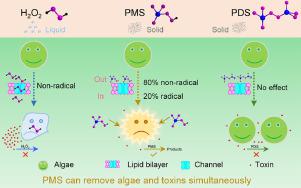Water Research ( IF 11.4 ) Pub Date : 2021-05-17 , DOI: 10.1016/j.watres.2021.117263 Zhihao Chen 1 , Jingyi Li 2 , Meiqing Chen 3 , Kok Yuen Koh 4 , Zhongrong Du 3 , Karina Yew-Hoong Gin 4 , Yiliang He 5 , Choon Nam Ong 6 , J Paul Chen 4

|
Harmful algal bloom (HAB) is one of the most globally severe challenges in ecological system and water safety. Hydrogen peroxide has been commonly used in the management/treatment. Solid oxidants (e.g., peroxymonosulfate (PMS) and peroxydisulfate (PDS)) may outperform liquid H2O2 due to ease in transportation, handling, and applications. However, the information on applications of PMS and PDS in algae treatment is limited. In this study, the two solid peroxides and H2O2 were investigated for the removal of the blue-green algae of Microcystis aeruginosa. H2O2 and PMS effectively removed algae in 2 d at pH 5.0, 7.0 and 9.0, while PDS was only effective at pH 5.0. The change in pH and the release of dissolved organic carbon were insignificant at 0.2 mM H2O2 and PMS. The PMS could degrade microcystin-LR and phycobiliproteins. The studies of phycobiliproteins degradation and scanning electron microscopy indicated that PMS might cause the cell inactivation mainly by damaging the chemical components in algae cell wall and membrane while H2O2 might mainly enter the cell to form oxidation pressure to kill algae. The scavenger experiments showed that radicals were not crucial in H2O2 and PDS applications. Similarly, the algae removal by PMS was obtained mainly by non-radical pathways; about 77% was direct PMS oxidation and no more than 3% was singlet oxygen-mediated process, while radical pathways of sulfate radical and hydroxyl radical accounted for 18% and 2%, respectively. For the realistic algae-contaminated natural water, the PMS effectively lasted for 60 d, while the H2O2 lasted for 12 d. This research work demonstrates that the PMS is promising in control of HAB. The findings can provide some useful design and application parameters of PMS technology for better management/treatment of algae-contaminated water.
中文翻译:

通过过氧化氢、过一硫酸盐和过二硫酸盐的过氧化物去除铜绿微囊藻,无需额外的活化剂
有害藻华(HAB)是全球生态系统和水安全方面最严峻的挑战之一。过氧化氢已普遍用于管理/处理。由于易于运输、处理和应用,固体氧化剂(例如,过硫酸盐(PMS)和过硫酸盐(PDS))可能优于液体H 2 O 2。然而,关于 PMS 和 PDS 在藻类处理中应用的信息是有限的。在本研究中,研究了两种固体过氧化物和 H 2 O 2去除铜绿微囊藻蓝绿藻的效果。H 2 O 2PMS 在 pH 5.0、7.0 和 9.0 下可在 2 d 内有效去除藻类,而 PDS 仅在 pH 5.0 下有效。pH 值的变化和溶解有机碳的释放在 0.2 mM H 2 O 2和 PMS 下是微不足道的。PMS 可以降解微囊藻毒素-LR 和藻胆蛋白。藻胆蛋白降解和扫描电镜研究表明,PMS可能主要通过破坏藻类细胞壁和细胞膜中的化学成分导致细胞失活,而H 2 O 2可能主要进入细胞形成氧化压力杀死藻类。清除剂实验表明自由基在 H 2 O 2中并不重要和 PDS 应用程序。同样,PMS 的藻类去除主要通过非自由基途径获得;约 77% 为 PMS 直接氧化,不超过 3% 为单线态氧介导的过程,而硫酸根和羟基自由基的自由基途径分别占 18% 和 2%。对于真实的藻类污染的天然水,PMS 有效地持续了 60 d,而 H 2 O 2持续了 12 d。这项研究工作表明 PMS 在控制 HAB 方面很有前景。这些发现可以为 PMS 技术提供一些有用的设计和应用参数,以更好地管理/处理被藻类污染的水。











































 京公网安备 11010802027423号
京公网安备 11010802027423号